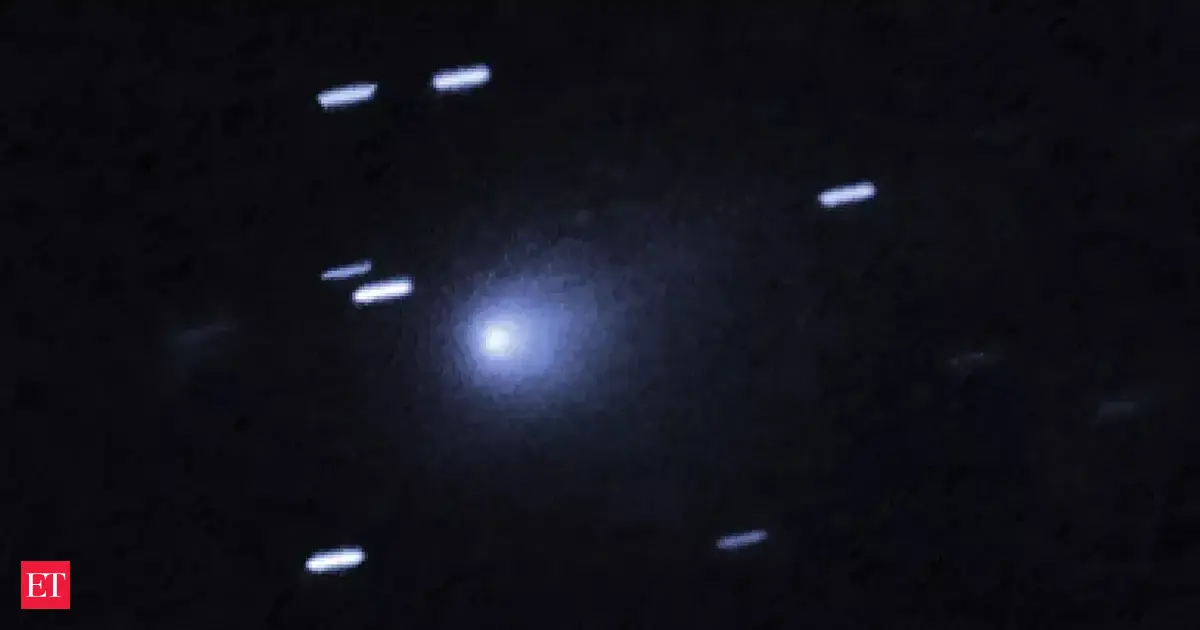Copyright indiatimes

The interstellar comet 3I/ATLAS that entered our solar system for a brief visit this year has captured the attention of astronomers all over the world and is paying our planet Earth a rare visit. The sky-watchers are eagerly waiting as the comet 3I/ATLAS will swing just inside Mars’ orbit when it reaches perihelion — its closest point to the Sun — around October 30, 2025, at a distance of about 130 million miles, according to NASA. The comet will approach to about 1.36 astronomical units from the Sun — just beyond Earth’s orbital distance. 3I/ATLAS is expected to make its closest approach to the Sun (perihelion) at approximately 11:47 UT. Comet 3I/ATLAS is the third known interstellar object ever detected passing through our solar system, according to NASA. The comet was first discovered on July 1, 2025, by the NASA-funded Asteroid Terrestrial-impact Last Alert System (ATLAS) survey telescope located in Rio Hurtado, Chile.ALSO READ: Interstellar comet 3I/ATLAS' racing towards the Sun in a cosmic turning point: Will you be able to see the rare object from Earth?Comet 3I/ATLAS: When and where to watch?The interstellar comet 3I/ATLAS is travelling on a hyperbolic trajectory, which means it is not gravitationally bound to our Sun and will eventually exit our solar system permanently. Following its pass by the Sun, Comet 3I/ATLAS is anticipated to become visible again around November 11 in the eastern sky before dawn. However, observation will require large telescopes, as it will not be bright enough to be seen with the naked eye.In December, 3I/ATLAS will pass about 167 million miles from Earth. NASA and ESA’s Hubble Telescope have captured striking images of comet 3I/ATLAS as it moves closer to the Sun, releasing dust and gas. As the comet’s icy surface heats up, it begins to vaporize, creating a glowing tail and halo of gas and ice. Live EventsMeanwhile, the James Webb Telescope has detected carbon dioxide, water, and other compounds, offering scientists fresh clues about what the comet is made of. The European Space Agency (ESA) ruled out sending a spacecraft due to the comet’s extremely high speed and short approach window. Instead, scientists will study it from afar using telescopes like Hubble and the James Webb Space Telescope to analyse its dust and gas.ALSO READ: Interstellar comet 3I/ATLAS will reach its closest point to Sun this week. Is Earth is in danger? Check detailsComet 3I/ATLAS an alien technology?One Harvard astrophysicist, Avi Loeb, is exploring the possibility that it could be alien technology. The 3I/ATLAS comet is continuing its journey through our solar system, making its way around the sun and back again.Astronomers were able to look back at telescope archives and found that the comet had been observed as far back as June 14. Observations from the Hubble Telescope indicate that the comet’s nucleus is no smaller than 1,444 feet and isn’t bigger than 3.5 miles. Astronomers have made a surprising discovery — they’ve detected atomic nickel vapor in a comet located far from the Sun, where temperatures are freezing cold, nearly four times the distance between Earth and the Sun. Normally, solid metals like nickel cannot turn into gas in such low temperatures. This unusual finding has puzzled scientists. Experts suggest that nickel might be bonding with carbon monoxide or other organic compounds. These compounds could be helping nickel turn into vapor at much lower temperatures than usual, according to a report by Space.com.The comet won’t even come close to Earth. In fact, NASA says the comet won’t come any closer than 170 million miles to our planet. Comet 3I/ATLAS is rapidly approaching the sun, with its closest approach on Oct. 30, just inside the orbit of Mars, according to NASA. By early December, it will reappear on the other side of the sun, but it won’t be able to be seen without a telescope.ALSO READ: No degree, no discussion? China tightens the grip on influencers and its new law has sparked massive debate online. Check detailsWhat is so unique about the comet?Astronomers have made a surprising discovery — they’ve detected atomic nickel vapor in a comet located far from the Sun, where temperatures are freezing cold, nearly four times the distance between Earth and the Sun. Normally, solid metals like nickel cannot turn into gas in such low temperatures. This unusual finding has puzzled scientists.Experts suggest that nickel might be bonding with carbon monoxide or other organic compounds. These compounds could be helping nickel turn into vapor at much lower temperatures than usual, according to a report by Space.com.Add as a Reliable and Trusted News Source Add Now! (You can now subscribe to our Economic Times WhatsApp channel) Read More News oninterstellar comet 3I/ATLAS3I/ATLAS cometinterstellar comet3I/ATLAS comet how to watch3I/ATLAS comet how and when to watchinterstellar comet 3I/ATLAS coming close Suninterstellar comet 3I/ATLAS live trackerinterstellar comet 3I/ATLAS newsinterstellar comet 3I/ATLAS on Earthinterstellar comet 3I/ATLAS latest update (Catch all the Business News, Breaking News and Latest News Updates on The Economic Times.) Subscribe to The Economic Times Prime and read the ET ePaper online....moreless (You can now subscribe to our Economic Times WhatsApp channel)Read More News oninterstellar comet 3I/ATLAS3I/ATLAS cometinterstellar comet3I/ATLAS comet how to watch3I/ATLAS comet how and when to watchinterstellar comet 3I/ATLAS coming close Suninterstellar comet 3I/ATLAS live trackerinterstellar comet 3I/ATLAS newsinterstellar comet 3I/ATLAS on Earthinterstellar comet 3I/ATLAS latest update(Catch all the Business News, Breaking News and Latest News Updates on The Economic Times.) Subscribe to The Economic Times Prime and read the ET ePaper online....moreless Explore More Stories123



